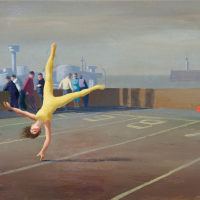12. JEFFREY SMART

Its a rare occurrence in Jeffrey Smarts work that we find a figure in motion let alone the strenuous, spectacular motion of a gymnast. Smart built his art on stillness, the kind of stillness found in the paintings of Piero della Francesca, as celebrated in monographs by Bernard Berenson and Kenneth Clark; or in those much-admired lines from T.S. Eliots Four Quartets:
Only by the form, the pattern,
Can words or music reach
The stillness, as a Chinese jar still
Moves perpetually in its stillness1
For Smart, stillness became a defining feature of his mature paintings. Aside from the acrobat in The Hovercraft, Boulogne 1986-87, the only other notable instances of movement may be The Construction Fence 1978, which depicts a small girl in a pink dress running with outstretched arms, or Central Station II 1974-75, in which we see a figure running away from us, down a sunlit corridor between two hoardings.
It could be argued that in the two earlier pictures, the figures are stiff, rather than fluid in their movements. Their actions only tend to throw the profound stillness and emptiness of the rest of the composition into even sharper relief.
The Hovercraft, Boulogne, and First Study for Waiting for the Hovercraft, Boulogne, are exceptions to the general rule. In the major painting there are three points of movement: the androgynous, cartwheeling acrobat in a bright yellow leotard, a girl in a red dress gyrating with a hula hoop, and a boy in the distance pushing another hoop. By Smarts usual standards this a virtual mele!
We know from an interview at the time,2 that Smart based the gymnast on the young Cosima Spender, daughter of his Tuscan neighbours, Maro Gorky and Matthew Spender, and granddaughter of the poet, Stephen Spender. She had to lie on the ground and strike a frozen pose while Smart made a sketch. So we can confidently refer to the acrobat as she.
In the First Study, with which we are primarily concerned here, there is only one moving figure, but that movement is extraordinarily violent. Where the acrobat in the major painting displays a degree of suppleness, with slight bends to the arms and legs, the one in the First Study, pitches into a cartwheel with one arm and both legs at full stretch. With the other arm she reaches out and touches the ground with the very tip of her index finger. The first figures hair is flicked back, but in the First Study the acrobats black hair seems to swing forward.
The contrast is made even more striking by the difference in settings. In The Hovercraft, Boulogne, the action takes place on a bare, greyish patch of earth presumably one of those wastelands that pass for a beach in Europe. In the First Study, the acrobat appears to be throwing herself around in a carpark with a dull, asphalt surface. A soft landing seems out of the question. The view in the distance reveals a disorderly jumble of industrial warehouses, storage depots and observation towers. In the final version, these signs of a working port have been removed, to be replaced by a neat, colourful row of parked vehicles, and a handful of figures strolling by the shoreline.
Smart has transformed a place of work into one of leisure, although the glowering sky and the overcoats worn by some of the figures dont make this beach seem especially inviting. No swimsuits are in evidence. All the activity is coming from the three young people in the foreground, who seem absorbed in their solitary games.
In the First Study, a group of figures lean against a low restraining wall, looking out to sea. They pay little or no attention to the cartwheeling acrobat, as if such things are so commonplace they barely deserve a second glance. This is the same weirdness one might find in a film by Luis Buuel, in which uncanny events are inserted seamlessly into everyday scenarios.
The adults in both pictures are so absorbed in the act of waiting; they are indifferent to the fleeting glimpse of beauty in their midst. This is a familiar theme for Smart, who was a connoisseur of the epiphany a moment of sudden revelation. Rather than a vision of the Blessed Virgin Mary, his revelation was more likely to come from a brightly coloured lorry, a traffic sign, an advertising hoarding, or some striking architectural detail. He found beauty in concrete structures and so-called transitionary spaces that most people would never notice.
Perhaps the young acrobat also recalls the commedia dellarte figures and saltimbanques that feature in the work of artists such as Picasso and Derain in that period we call the Return to Order, when Modernism took a classical turn. Such tendencies were prominent in Italian art of the 1930s and 40s, and Smart, as a long-term resident of Italy, was heir to those pictorial ideas. Looked at from one angle, his paintings derive from the artists of the Renaissance and Nicolas Poussin (1594-1665); from another, his sensibility is that of a Modernist who sets out to disrupt our complacent ways of seeing. He wants us to stop staring at the grim, grey sea, turn around, and enjoy the sudden spectacle that creates a moment of wonder in an otherwise ordinary day.
Footnotes:
1. Eliot, T., Burnt Norton (1935), from The Four Quartets, in Collected Poems 1909-1962, Faber & Faber, London, 1974, p.194
2. Baum, C., Smart the Urban Aesthete, The Herald, Melbourne, 24 April 1989, p.19 (with thanks to Stephen Rogers, Archivist for the Estate of Jeffrey Smart, for this reference)
John McDonald
John McDonald is the author of Jeffrey Smart: Paintings of the 70s and 80s. He writes a weekly art column for the Sydney Morning Herald and a weekly film column for the Australian Financial Review.